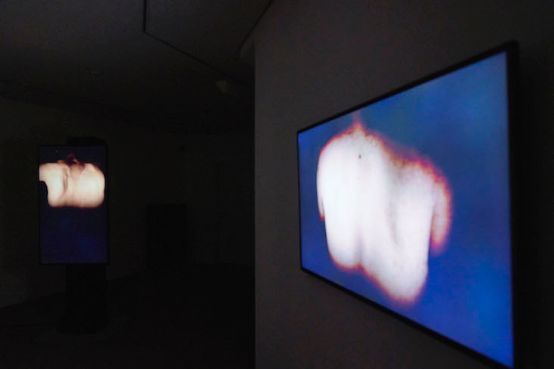A big hit
The Wittener Tage für neue Kammermusik from April 27 to 29 impress with their interpretative and compositional quality.

Professional music-making is high-performance sport and muscle play. In her sound and video installation Quartet. Bodies in Performance Katharina Rosenberger, born in Zurich in 1971, shows the bare backs of four musicians. Shoulder blades move, tendons protrude, as do strong muscles, trained over decades of practicing. Rosenberger did not compose a closed quartet for her installation, but loosely arranged solo pieces for piano, percussion, accordion and double bass. She is experienced enough in multimedia to know that the visual and audible should meaningfully cross-fertilize each other and not be dominated by sound or visuals. She also did well not to synchronize the videos directly with the music. This increases the viewer's attention. There is room to think further, to ponder, to reflect.
Rosenberger's focus on performers fits in well with the Wittener Tage für neue Kammermusik. The annual festival always impresses with outstanding musical performances. This time, the experienced new music specialists were joined by the furious piano duo Grau/Schumacher and the young musicians of Trio Catch. Alternating with the pianists, the trio intoned a obsessive compulsive music by the young Brazilian Ricardo Eizirik, who lives in Zurich. He has the trio repeat short, rhythmically concise motifs ostinato. Boglárca Pecze (clarinet), Eva Boesch (cello) and Sun-Young Nam (piano) master the delicate rhythms of an inspired piece with incredible precision. No less convincing is the interpretation of Rosenberger's trio surge. The thinned-out sound is always transparent here, and the general pauses of another very impressive work are set full of suspense, for which one wishes many more performances after the Witten premiere.
Essence and density
It is usually difficult to sum up a new music festival with more than 20 world premieres. In Witten this time, there were no ups and downs, no - at times laborious - alternation between experimental failures, the routine and the conciliatory and impressive. Thanks to outstanding performers, but also thanks to almost consistently exceptionally inspired composers, the cleverly programmed festival director Harry Vogt achieved a great success. The intensity of the 35-minute Epigram I-IIIwritten by French composer Franck Bedrossian for soprano Donatienne Michel-Dansac and Klangforum Wien. Michel-Dansac sings texts by the American author Emily Dickinson. She traces the content of the texts with equal flexibility and color, while the ensemble sometimes serves as an "echo chamber", sometimes as a ravenous commentator, sometimes as a partner to the soprano, who nestles into the sound and at times merges with the singing. Bedrossian pulls out all the stops in his computer-assisted composition. He knows how to orchestrate with virtuosity and has a pronounced sense of dramaturgy. At no point in the work does he let the reins slip. It is all essence, dense and concentrated.
Further highlights come from Mark André, Johannes Maria Staud and Georg Friedrich Haas. In keeping with his personal style, he once again presents sound mixtures that only he seems to be able to achieve. Violent piano clusters mingle in the trio Flower meadow I-III with the multifonts of saxophonist Marcus Weiss and the percussive accents of percussionist Christian Dierstein. Mark André and the Austrian Johannes Maria Staud pursue similarly subtle sound work. In Mark André's world premiere ...blessed are... spaces of disappearance there is a rare encounter between live electronics and a clarinet. Jörg Widmann roams the rooms of the Märkisches Museum in Witten with his instrument. Only the end resounds - ritually, even religiously charged - in the midst of the audience. Thanks in part to the SWR experimental studio, the close interlocking of instrumental notes with the digital spheres from the loudspeakers is particularly fascinating. In the light II is what Staud calls his duo for two pianos. It is a kind of self-exploration, as he looks back on an orchestral work that is around ten years old. What he has "gained" or "lost" over the course of time - that is what he wanted to trace in this expressive work. In the end, the Witten visitor also won, rewarded by an exceptional vintage that offered nuances of taste in all forms.








